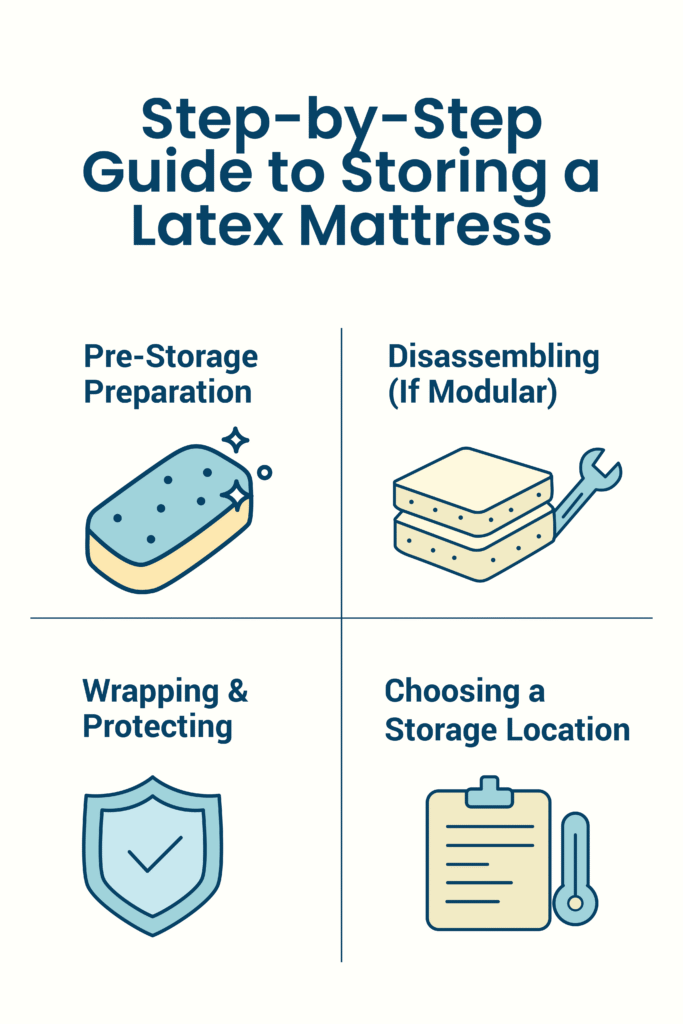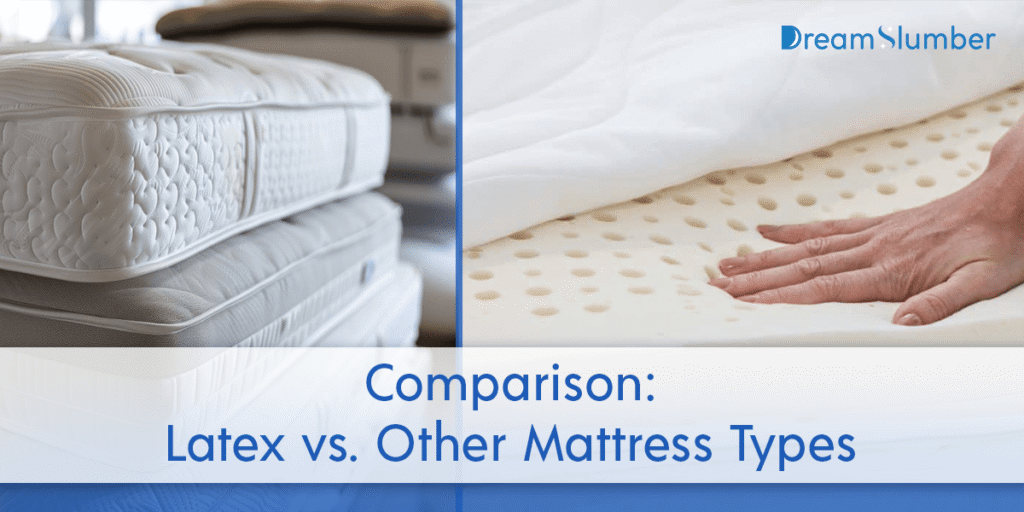When you purchase through our links, we may earn a commission at no extra cost to you. As an Amazon Associate, DreamSlumber earns from qualifying purchases. Learn more.
You spent thousands on a natural latex mattress for better sleep and fewer allergies. Now you need to store it.
Maybe you’re moving across the country. Perhaps you’re renovating your bedroom. Or you’re temporarily downsizing your living space. Whatever the reason, that expensive mattress sitting in your garage could become an expensive mistake.
Here’s what most people don’t realize: Latex mattresses are incredibly sensitive to storage conditions. Store them wrong, and within weeks, you’ll have a moldy, warped mess that no longer supports your back. The natural materials that make latex so healthy for sleep also make it vulnerable to damage.
The Sleep Products Safety Council reports that improper storage causes more damage to latex mattresses than regular wear and tear. Temperature swings, moisture, and compression can permanently damage your mattress’s structure. Once damaged, even the best warranty won’t be of any help.
But proper storage isn’t complicated. This guide shows you exactly how to store a latex mattress using proven methods that preserve its natural benefits. You’ll learn the specific steps, optimal conditions, and common mistakes that destroy latex mattresses in storage.
Why Proper Storage Matters for Latex Mattresses
Preserving Natural Hypoallergenic Properties
Your latex mattress has tiny air pockets that naturally resist dust mites and mold, preserving its signature buoyant support and distinctive comfort feel that many sleepers love. According to the Asthma and Allergy Foundation of America, these properties make latex ideal for allergy sufferers or those managing chronic pain conditions. Hypoallergenic mattress care during storage helps maintain these benefits.
Moisture is latex’s enemy. When humidity enters those tiny air pockets, mold can grow and destroy the natural protection. Proper storage keeps your mattress dry and maintains its ability to provide cleaner air while you sleep.
Extending Lifespan (8-10+ Years)
The International Sleep Products Association confirms that the lifespan of a quality latex mattress reaches 8 to 10 years with proper care. Heat and moisture significantly reduced this time. Your storage method directly affects how long your mattress stays supportive.
Climate-controlled storage prevents the expansion and contraction that can break down latex. Think of it like storing fine wine. Consistent conditions preserve quality. This care ensures your mattress continues to support a healthy sleep posture for years.
Protecting Your Investment
Natural latex mattresses cost more because they last longer and offer health benefits. The Better Sleep Council notes that premature replacement costs families thousands of dollars. Smart storage protects your budget and your sleep quality.
Your mattress warranty tips matter here, too. Most manufacturers require proper storage to maintain coverage. Following these guidelines protects both your mattress and your warranty rights.

Step-by-Step Guide to Storing a Latex Mattress
Pre-Storage Preparation
First, learn how to clean latex foam safely. Mix one tablespoon of baking soda with two cups of water and a drop of mild dish soap. Gently clean the surface with a soft cloth, using minimal moisture.
Let your mattress dry completely in a shaded area with good airflow. If you’re relocating, pair this with safe latex mattress transport techniques to prevent damage during transit. The Rubber Manufacturers Association recommends a minimum of 6 hours of drying time. Complete drying stops mold before it starts.
Note: Never use harsh cleaners or bleach on latex. These chemicals permanently break down the material.
Disassembling (If Modular)
Modern modular latex layers come apart for easier handling. Remove each layer gently and record which one goes where. Mark the storage bags as “soft,” “medium,” or “firm” so reassembly is simple.
Keep layers flat when possible. Stacking is okay if you must, but put firmer layers on the bottom. This prevents the soft comfort layers from compressing too much.
Wrapping & Protecting
Select the best mattress bags designed for storing your mattress. The Sleep Products Safety Council recommends breathable cotton or specialized mattress storage bags. These non-toxic storage solutions let air flow while keeping dust and pests out.
DIY mattress protection tip: Place silica gel packets (available at craft stores) around your wrapped mattress for moisture protection. Use about 10 packets for a queen-size mattress. Keep packets in their original pouches. Never open them or let gel touch the latex.
Pro Tip: Old cotton bedsheets work as an extra breathable layer under your storage bag.
Choosing a Storage Location
Find ventilated storage spaces with steady temperatures between 60°F and 75°F (15-24°C). The American Chemistry Council’s Polyurethane Foam Association notes that temperature swings cause material breakdown. Basements and attics often experience excessive moisture and significant temperature fluctuations.
Raise your mattress at least 6 inches off the floor using wooden pallets or a platform. Ground moisture is a hidden enemy in the long-term storage of mattresses. Good airflow underneath prevents trapped humidity.
Common Mistakes to Avoid
Folding or Rolling Long-Term
Latex bends but has limits. The International Association of Bedding and Furniture Law Officials states that latex can stay rolled for a maximum of 30 days. Longer periods create permanent creases that won’t flatten out.
Think of latex like a sponge. Squeeze it briefly, and it bounces back. Squeeze it for months and it stays flat. Keep your mattress flat for storage longer than one month.
Using Non-Breathable Covers
Regular plastic may seem protective, but it actually creates a moisture trap. Your mattress needs to breathe to stay healthy. Mold prevention tips from the CDC consistently emphasize the importance of airflow over sealing.
Plastic creates a mini greenhouse where mold loves to grow. Even small amounts of trapped moisture become big problems. Always choose breathable materials for safe storage.
Warning: Never use regular plastic sheeting or garbage bags for storing a mattress.
Ignoring Climate Control
The Rubber Research Institute of India indicates that latex becomes brittle at temperatures below 50°F and too soft above 85°F. These changes permanently affect support quality. Humidity control above 60% encourages mold growth within days.
Uncontrolled environments age your mattress years in just months. The small cost of climate-controlled storage saves thousands in early replacement. Your spine will thank you for this investment.

Comparison: Latex vs. Other Mattress Types
Understanding the differences between latex and memory foam storage helps you choose the right method. Each material has unique needs based on its structure.
| Factor | Latex | Memory Foam | Innerspring |
| Flexibility | Moderate (layers) | High (rollable) | Low (rigid) |
| Humidity Sensitivity | High | Moderate | Low |
| Max Storage Time Rolled | 30 days | 60 days | Not recommended |
| Climate Control Needs | Essential | Important | Moderate |
| UV protection for latex | Critical | Important | Minimal |
| Best Storage Position | Flat only | Flat preferred | Flat only |
Your latex mattress needs extra care compared to other types. This careful storage preserves the natural materials that make latex healthier for sensitive sleepers.
Wellness Benefits of Proper Latex Mattress Storage
Reducing Allergen Exposure
The American Academy of Allergy, Asthma & Immunology confirms that proper storage prevents allergen buildup. Clean, dry storage stops mold spores and dust mites from making your mattress their home. When you unpack your mattress, it’s as fresh as when you stored it.
Bed bug prevention happens naturally with good storage. The National Pest Management Association notes that elevated, sealed storage prevents pests from accessing areas. Your family breathes easier knowing the mattress stays clean.
Maintaining Spinal Alignment
Physical therapists know that mattress support zones affect spinal health, and mattresses work together to support it. Proper storage keeps these zones intact. Each area of your mattress is designed to maintain the right firmness for different body parts.
Storage damage creates dips and soft spots where you need support most. Your lower back especially needs consistent support. Protecting your mattress structure means protecting your back health.
Eco-Friendly Practices
Natural latex comes from rubber trees, a renewable resource. The Forest Stewardship Council recognizes latex as one of the most sustainable sleep products available. Eco-friendly mattress storage extends this sustainability by making mattresses last longer.
Use natural cedar blocks instead of chemical pest control. Choose reusable cotton bags over disposable plastic. These small choices add up to big environmental benefits.

Frequently Asked Questions
Can I store a latex mattress vertically?
No, vertical storage does not cause permanent sagging in latex mattresses. The material slowly shifts downward under the influence of gravity, creating thin spots at the top and thicker areas at the bottom. Always store flat to maintain even support across the entire sleeping surface.
How long can a latex mattress stay compressed?
New latex mattresses are designed to tolerate compression for a maximum of two weeks during shipping. Used mattresses with separate layers can stay rolled for up to 30 days. Beyond these limits, the material loses its ability to spring back, leaving permanent indentations.
Does latex attract bed bugs in storage?
Clean latex rarely attracts bed bugs, as these pests require fabric fibers and a regular food source. Proper cleaning before storage and using sealed bags eliminates any minimal risk. Elevated storage provides extra protection by keeping the mattress away from potential pest entry points.
Can I use mothballs or essential oils?
Skip mothballs since their chemicals damage latex and create toxic fumes that the material absorbs. Cedar blocks provide natural pest control without harm. Essential oils may permanently stain latex, so keep them away from direct contact with your mattress.
Is sunlight exposure harmful?
Yes, UV rays break down latex quickly through a process called photo-oxidation. Even one day of direct sun causes surface damage. Store in complete darkness and limit sun exposure during cleaning to under one hour of indirect light.
How to prevent mold in humid climates?
Run dehumidifiers to maintain storage areas at a humidity level below 50% throughout the year. Use moisture-absorbing packets and check them monthly for optimal performance. The EPA recommends breathable covers that allow air circulation while blocking liquid water. Never use plastic in humid areas.
Can I stack latex layers?
Yes, stack latex layers with firm pieces supporting softer ones underneath. Place cardboard between different firmness levels to prevent impressions. Support the entire surface evenly, as hanging edges create stress points that can lead to permanent damage over time.
Should I vacuum-seal my latex mattress?
Never vacuum-seal latex mattresses, as extreme compression can permanently damage the material’s cell structure. The Polyurethane Foam Association warns against compression beyond 50% of the original height. Gentle wrapping in breathable materials provides protection without causing damage from compression.
Conclusion
Proper storage keeps your latex mattress ready to support restful, healthy sleep for years to come. Climate-controlled storage, thorough preparation, and breathable protection work together to preserve your investment. These simple steps protect both your wallet and your wellness. Check your stored mattress every few months to ensure conditions remain ideal. Share these tips with friends who value quality sleep and natural materials. Understanding how to store a latex mattress correctly means better sleep and improved health when you need it again.


